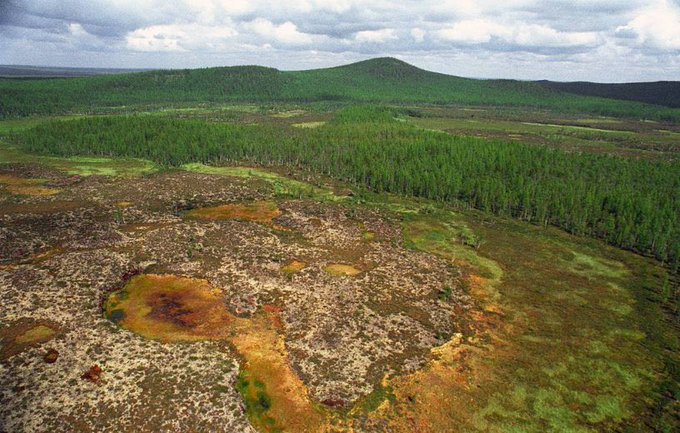Scientists think they’re so smart, just because they can explain everything! But even the smartest folks get stumped from time to time or at least come across a problem where the answer isn’t set in stone. From mysterious shipwrecks to eternal flames, here are some discoveries and phenomena from across the world that have left scientists scratching their heads!
The Great Pyramid Void
Generally speaking, the older something is, the less novel and surprising it is. With that in mind, there aren’t many manmade things on this earth older than the Great Pyramid of Giza. Considering it’s been around for close to 4600 years, it can't have many more secrets or surprises in store for us, can it?
A few years back Egyptologists announced they had discovered what they called a
Deep Void in the pyramid. This void consists of an empty space around 100 feet long, and up to 230 feet above ground.
The discovery is strange for two reasons; firstly, as mentioned earlier, this pyramid is old, and we thought we’d explored every nook and cranny by now. Secondly, we don't know what the purpose of the deep void was. Even more strangely, the deep void was blocked by a large granite stone, so it wasn't just a deep void, it was a secret deep void, and we have no idea why it was kept a secret. Furthermore, a new
mysterious chamber has been discovered in the Great Pyramid in 2023. Who knows what other secrets the emblematic landmark keeps from us?
New discovery inside Great Pyramid of Giza reveals hidden secrets by TODAY
Blood Rainbows
At some point in your life, you’ve probably been blessed by the multicolored hues of a gorgeous rainbow hanging in the sky. If you have great karma, you may have even witnessed the chromatic splendor of the rare double rainbow. On the other hand, if you’ve really ticked off someone upstairs, they might blight your skies with a blood rainbow.

The phenomenon is exceptionally rare to boot! Regular rainbows occur when light shines through water droplets in the atmosphere which, at the right angle, act as a prism. This scatters the light waves to create colorful arches! Red rainbows, however, are much more difficult to explain, and many sky watchers and meteorologists have gone their whole careers without ever observing one. The current explanation for the morbid rainbows is that they can only occur when the sun is low in the sky, around early sunrise or late sunset. At this time of day, the blue and green light from the sun is weakened by the Earth’s atmosphere. This means that when the light refracts off water in the atmosphere, it ends up dying what would be a typical, chirpy rainbow an ominous red.
Tunguska Trouble
If a tree falls in the forest and there’s no one around to hear it, does it make a sound? Well, what about millions of trees suddenly exploding? That would probably be pretty loud, and it’s exactly what happened in the Siberian forests of Russia all the way back on June 30th, 1908.
That morning, an estimated 80 million trees were completely flattened in these remote forests, with a rumbling noise that could be heard from miles away. One man who experienced the event was sat on his porch, only to be knocked off his chair with a red-hot feeling all over his body and he was in Vanavara, 40 miles away.

Even as far as the U.K., the event was measurable on seismic detectors, and registered as high as 5.2 on the Richter scale. You might think that a literally groundbreaking mystery explosion would warrant an immediate investigation, but the Russians didn’t get around to it until 1927, 19 years later. It was Leonid Kulik of the St. Petersburg Museum who eventually trekked out into the freezing cold wilderness of Siberia. He discovered a mind-blowing eight hundred square miles of trees had been completely flattened away from a single point. Kulik theorized this must have been the blast’s origin zone, with the most likely cause being meteoric impact. There was only one problem: the rock left no trace behind! It was almost like the trees just got tired and gave up on standing. The best explanation we currently have is that the blast was caused by a space rock that exploded before hitting the ground.
It’s estimated the rock was around 120 feet across and weighed 220 million pounds, which is four times the weight of the statue of liberty, and that on entry it reached a temperature of around 44,500 degrees Fahrenheit. This heat, combined with the quick change in atmospheric pressure, caused it to detonate with the force of nearly 185 atomic bombs. Still, due to the nature of the event, this is just our best current explanation with others believing it was caused by, who could have guessed, aliens.
Exploding Toad Syndrome
In the mid-2000s, residents of Hamburg, Germany, bore witness to something grotesque: toads spontaneously exploding, for seemingly no reason. In some cases, toad guts were expelled as far as a yard from the poor desecrated amphibians. Upon further investigation, upwards of a thousand toad bodies were discovered in the area.
Scientists tested the nearby pond’s water quality, searched for any dangerous fungi, and even hypothesized the frogs had contracted a strange offshoot disease from horses at a nearby racetrack. Much like the poor toads, however, none of these theories held water. Upon closer examination it was found that, strangely, the toads all had circular incisions on their backs and were missing their livers. This led scientists to the conclusion that the explosions were the fault of crows, who really do continue to be the most dastardly birds on the planet.
The clever crows figured out that the toads’ skin was poisonous, but also that with a swift stab they could pluck a toads’ liver out with their beaks. This caused the toads severe internal damage and, when the toads would puff themselves up as a part of their defense mechanism, their lungs would continue to stretch and inflate to the point of bursting.
The Dance of Death
Our next tale of the inexplicable takes us to the small German town of Strausberg, in the year 1518. One summer morning, Frau Troffea stepped out of her home, and spontaneously broke into a dance. She boogied all day, and the next morning at the crack of dawn, burst into the streets and boogied once more, like only medieval Germans could.
Troffea danced until her feet were bloody, and eventually attracted a crowd. Despite the lack of music, some kind of earworm was going around, as other townsfolk began to join her. The
dancers had no idea why they were dancing, some were clearly in pain, while others claimed to feel possessed. Upwards of 400 people joined the impromptu rave, which is way livelier than my local club. What wasn’t so lively was the dancers themselves, as they began dropping like flies.
This is because many of the townsfolk were old, or just not cut out for hours of dancing in the summer sun. But what a way to go! Strausberg physicians diagnosed the dancers with the awesomely named
hot blood affliction. The cure they came up with was to hire musicians to liven things up, thinking folks would tire themselves out and go home. As you might imagine, adding more bass didn’t help, and at this point 15 people were dabbing themselves to death every day.
Eventually Strausberg took the Footloose approach and banned music all-together, but of course, this didn’t stop the crazed dancers. What did eventually work was, for some reason, carting the dancers up a mountain in honor of Saint Vitus. He was the guy you went to if you had a trembling-related illness. To this day, the most convincing explanation was that the townsfolk were suffering from a case of mass hysteria, which is a broad term that describes when large groups of people suffer simultaneous mental breakdowns. This is sort of understandable, seeing as the region was devastated by a famine in 1517, before leprosy and smallpox broke out in early 1518.
The Lightning Hours
Watching thunderstorms can be an amazing experience. There’s something incredible about witnessing the majestic-yet-destructive power of nature dancing across a dark sky, unless, of course, you live near the Catatumbo river in Venezuela, where thunderstorms are less awe-inspiring and more gridlock level of annoying.
This is because near the mouth of the Catatumbo, lightning storms can last for ten hours at a time and can occur as many as 150 days out of the year. That means that this small area of Venezuela receives 1.2 million lightning strikes per year, which is more than the UK, Germany, and Sweden combined!
According to the National Oceanic and Atmospheric Administration, most lightning storms tend to last between 10 and 20 minutes, so a ten-hour lightshow is pretty baffling. The current theory is that there is no clear reason: the area simply has a perfect storm of lightning-generating conditions! Warm temperatures, high moisture in the air from the proximity to the sea, and mountainous terrain which cool air is forced over before hitting the warm, turbulent air rising from the river basin. These conditions prove perfect for thundercloud formations, which float 16,000 feet above the Catatumbo. And once they start thundering, they rarely stop.
Sloth Tunnels
These days, sloths are known for their slow reflexes, tree-hugging, and lackadaisical attitudes but they have actually mellowed out over the years. Sloths haven’t always been the lazy lumberers we know them as today. In fact, a few thousand years ago, they were getting stuff done.
According to Heinrich Frank, Professor at the University of the Rio Grande, giant sloths were, unbelievably, tunneling through the earth at a power and speed that would put modern jackhammers to shame, as recently as 10,000 years ago.
Sometime in the 2000s, Frank
discovered an enormous network of tunnels near the sleepy little Brazilian town of Novo Hamburgo. These tunnels bore huge clawmarks along the walls and were as tall as six feet in most areas, which is more than enough space for a human to stroll through. If that wasn’t crazy enough, the largest of these tunnels is 2000 feet long, that’s nearly twice as long as the Eiffel Tower is tall! Frank and his team believe the tunnels are the work of multiple generations of giant sloth, who in total must have moved 4400 tons of Earth, that’s the equivalent of 30 houses worth of dirt.
While the exact species of sloth isn’t known, it was possibly Darwin’s Ground Sloth, a species that could grow up to 10 feet long. Other researchers believe the tunnels may even be the work of an extinct species of giant armadillo. To be honest, both of these answers sound cool to me. I wonder which would have won in a fight, though?
The Bay of Jars
Roughly 15 miles from the heart of sunny Rio de Janeiro sits Brazil’s idyllic Guanabara Bay, a gorgeous but filthy bay. But underneath those azure waves lies a mysterious secret, one that might have been undisturbed for thousands of years.
While enjoying a little deep-sea exploration, American archeologist Robert Marx stumbled upon something strange. He
found a perplexing mass of ceramics.
Marx identified the pots as amphorae, which is nerd speak for tall jars. These jars were typically used aboard ships to store grain and wine on long voyages, but what makes the amphorae so baffling is the fact that they’re from ancient Rome. If you’re scratching your head right now because you don’t remember learning about any Roman expeditions to the Americas, you’re right. The first Europeans arrived in South America in 1492, and there’s evidence that Vikings had a small settlement in North America some 500 years before that.

These Roman pots, however, date back to the 3rd Century BCE, meaning they’re 1300 years older than even the Viking settlement. This discovery had obvious, profound implications for our understanding of the continent’s history, and raised plenty of questions. How did they get there? Was a distant shipwreck swept towards the bay? Did the Romans ever step foot on South American soil? Not long after the incident, Brazil barred Marx from entering the country and placed a
country-wide ban on underwater exploration. Others have theorized the country might simply be trying to preserve the myth that the land was discovered by the Portuguese. Actually, that’s not such a crackpot theory.
Permanent Fire
Our next entry concerned something called the eternal flame. It doesn’t reside on Pandora, though, but our own terrestrial Chestnut Ridge National Park in New York. Situated along a short trail, the eternal flame falls site marks a smoldering fire inside a small cave.
Crystal-clear water trickles over the mouth, the site looks pretty cozy, and the fire looks like it was lit by campers just a moment ago. In fact, the
eternal flame has been burning inside that cave for potentially thousands of years!
Though it’s impossible to tell, it’s theorized the flame was first lit by Native Americans several thousand years ago. It may be small, but considering most people can’t keep a match lit long enough to light a few candles on a birthday cake, it’s still pretty impressive! The eternal flame isn’t the only permanent fire on Earth, though. The most well-known and flashy is probably
Turkmenistan’s Darvaza Crater, colorfully nicknamed the gates to hell for obvious reasons.
The thing is, as imposing as Darvaza is, we at least understand it. The crater is simply above a large natural deposit of methane gas which caught fire and has been smoldering ever since. What’s especially strange about the eternal flame, however, is that scientists still aren’t certain of its cause. Previously it was thought that the flame was kept alight by an underground deposit of ancient and extremely hot minerals, which contributed to the production of natural gasses. Researchers at Indiana University recently uncovered, however, that the minerals in this location are much cooler than previously thought possible for the production of natural gas.
This means the flame continues to burn using gas produced by as-yet unknown means, the future study of which may reveal revolutionary methods for producing gas. Also, despite its grandiose name and ability to stay burning even in the cold, the eternal flame is not quite eternal, and has gone out several times before being re-lit.
Three Whale Rock
Hin Sam Wan, also known as Three Whale Rock, is a collection of three enormous sandstone rocks situated in Thailand’s Isan region. It’s so named because they look like a family of magical ancient stone whales that swim through the leaves of the jungle.
Image data not available
Three-Whale rock is a staggering 75 million years old, meaning these rocky whales have existed on Earth longer than actual whales, which have been around just 50 million years. The rocks are reachable via an extensive network of trails through the jungle, and the view from the top is quite breath-taking. From the 980-foot-high precipice, visitors are able to see the Mekong coast, the Phu Wua forest, and the Pakkading mountains of Laos. Just be careful up there, as there aren’t any guardrails!
3 Whale Rocks, Incredible Rock Formations in Thailand National Forest by b_theeraphan Though the area was seldom visited by tourists until the late 2010s, the region's Buddhist monks had known about the site for a long time, and some of their old huts still stand nearby.
So, how do three enormous sandstone rocks end up jutting out of the jungle? Well, that’s still a bit of a mystery. Sandstone is formed when tiny grains of minerals like quartz and feldspar compact over millions of years. Thailand has a potentially substantial amount of these minerals across the country, which does explain the whales’ component materials. What isn’t clear is what would have compacted those materials into such specific shapes while a jungle grew around them. Maybe they’re just taking their time enjoying a particularly tasty buffet of stone krill?
Snow Donuts
It’s time to talk about snow donuts! And no, I don’t mean when a car does donuts in the snow, sick as that may be. I’m referring to the image below; an actual, giant donut made of snow.
This peculiar hoop was spotted by a maintenance crew in Washington along the North Cascades Highway in Washington, DC. Now while this may look like the work of a particularly creative and patient kid, the donut’s photographer, Mike Stanford, a seasoned avalanche forecaster, is certain snow donuts are a naturally occurring phenomenon.
But what could cause something so perfectly round and delicious looking? According to Stanford, the donuts occur when a clump of snow falls from a tree or cliff face. If the conditions are just right, when the snow falls it will form a ball, and when it lands the center will collapse in on itself, leaving us with a snownut, or snow roller, as they’re typically called. Despite this explanation, Stanford notes that the
snowy disc he captured is exceptionally big, bigger than he’s ever seen before. It appears to be about 26 inches tall, with an 8-inch hole in the center, which probably isn’t big enough to fit your head through.
Jatinga Bird Mystery
What’s that old saying? “Birds of a feather kamikaze together…”? Well, it certainly is in the village of Jatinga, Assam! For most of the year, Jatinga is a small, scenic, sleepy village of around just 1200 residents. In August and September, however, the humble little town becomes a bloody bird bath.
During those two months, locals in Jatinga hang lanterns from poles, which the birds are drawn to like moths to a flame. The birds will groggily flutter down towards the lanterns. Some injure or even remove themselves from the gene pool on the way down, while others are plucked from the air by locals.

This phenomenon only occurs for a limited time in Jatinga, and is especially strange as it doesn’t just affect particularly stupid birds of a single species, but a wide variety. It was originally thought the birds might be migratory, and thus more easily confused by unknown surroundings, but further investigation revealed that most of the birds behaving this way are local and familiar with the region. The only clue scientists currently have is that most of the birds affected are diurnal, meaning they’re usually active during the day, but for some reason are compelled to fly around and get in accidents like a bunch of drunk drivers for a few months in Jatinga. According to one source, during these two months of bird accidents, the locals eat well.
This story bears a sordid resemblance to that of the
Overtoun Bridge in Scotland, which dogs just can’t help but throw themselves off of. Since the 1950s, over 600 confused pooches have leapt from the bridge, some to their unfortunate demise. The leading theory here is that the trees and foliage nearby the bridge conceal how steep the drop actually is. Additionally, some suggest the smell of small animals like mink nearby the bridge might entice and excite the dogs into haphazardly jumping over the side. But this is all guesswork, as one local hunter has gone on record stating there aren’t actually any mink in the area.
It's raining catfish and dogs!
Birds falling out of the sky is creepy, but it at least makes sense, on some level. Well, what if I told you that fish can also fall from the sky! Not only that, but it’s also probably a whole lot more common than you think.
There are dozens of stories of individuals like Lisa Lobree, who was
hit in the head by a falling catfish in 2016, and a Florida family whose pool was invaded by a falling fish in 2017. You don't need to be a biologist to remember that fish swim in water, not fly in the sky. After some bickering, a few consensuses on these events have been reached regarding these fishy free-falls. In many lone instances of pedestrians being pelted by fish from above, they live in areas with large birds of prey. Thus, it can be assumed that a bird caught a fish only to come down with a case of butter-talons mid-flight, dropping it on the unsuspecting victim below.
In some cases, scientists even theorize these fish may have been regurgitated mid-flight. As if being hit by a free-falling non-digested fish wasn’t bad enough! While this may explain singular fish-hits, in instances where dozens of fish reportedly fall from the sky, this explanation just doesn’t cut it.
What’s more likely in these cases is that violent winds, waterspouts, and updrafts sweep the poor animals into the air, where they likely spend a few panicked and confused seconds, before plummeting down to the Earth below. If you were amazed at these mysterious discoveries, we have covered a whole load of them for you
here. Thanks for reading!








































